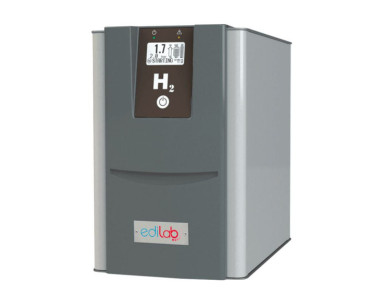EC5C Оборудование для топливного элемента PEM, управляемое компьютером (ПК)
ИННОВАЦИОННЫЕ СИСТЕМЫ
The Computer Controlled PEM Fuel Cell Unit, "EC5C", has been designed to allow the students to understand the fuel cells technology, especially that of a proton exchange membrane fuel cell (PEM).
Расширения
ЛАБОРАТОРИИ
НОВОСТИ ПО ТЕМЕ
ОБЩЕЕ ОПИСАНИЕ
The Computer Controlled PEM Fuel Cell Unit, "EC5C", has been designed by EDIBON to allow the students to understand the fuel cells technology, especially that of a proton exchange membrane fuel cell (PEM). It also enables to calculate several fundamental parameters of a PEM type fuel cell, such as power density, polarization curves, efficiency, etc., and the variation of some of these parameters in function of the consumption of reagents and the developed power.
The "EC5C" unit is supplied with a stack of proton exchange membrane fuel cell (PEM) with a rated power of 100 W. The stack is composed of 24 cells with the shape of channeled plates that allow the air flow through the membrane. The membrane facilitates the hydrogen flow, generating the electrons release. There are separating plates which conduct electricity, allowing thus such electrons flow, between each pair of cells.
Cells are self-humidifying and do not require any type of external humidification.
The stack has an integrated fan able to provide the required air for good operation and to maintain the appropriate temperature.
Hydrogen storage represents one of the essential points regarding the hydrogen economy. For that purpose, includes two pressure regulators, one of them is prepared to be installed in the H2 bottle in order to regulate the outlet pressure at 5 – 50 bar, the other is placed at the outlet of the metal hydride bottle in order to regulate the inlet pressure to the stack in a range from 0 – 1 bar.
Two solenoid valves are included. One of them is located before the stack and controls the hydrogen inlet and when the unit is switched off, the valve is closed to avoid any possible hydrogen leakage. The other valve, placed at the stack outlet, purges the excess of water and hydrogen towards the exterior for a proper operation.
A load regulation system enables the study of the generated electrical energy, the representation of the characteristic operation curves and their comparison with the theoretical curves. It includes a variable power rheostat, which enables to vary the generated power.
A battery supplies 12 V to the unit interface.
The whole electrical circuit of the stack is protected by a short circuit unit in case of an over current (12 A) and low voltage shut down (12 V).
It includes a hydrogen leak detector with a detection range from 0 – 2% Vol and from 0 – 100% L.E.L. (Lower Explosive Limit) respectively.
This Computer Controlled Unit is supplied with the EDIBON Computer Control System (SCADA), and includes: The unit itself + a Control Interface Box + a Data Acquisition Board + Computer Control, Data Acquisition and Data Management Software Packages, for controlling the process and all parameters involved in the process.
УПРАЖНЕНИЯ И ПРИМЕРЫ С ИНСТРУКЦИЯМИ
РУКОВОДСТВО ПО ПРАКТИЧЕСКИМ УПРАЖНЕНИЯМ ВКЛЮЧЕНО В РУКОВОДСТВО ПОЛЬЗОВАТЕЛЯ
- Study of the fundamental principles of how the PEM based fuel cell operates.
- Study of the structure and main principles of a metal hydride cylinder.
- Calculation of a fuel cell efficiency.
- Study of the influence of air consumption and hydrogen in the efficiency of a fuel cell.
- Study of the influence of generated power in the efficiency of a fuel cell.
- Determination of the current density-voltage characteristics of a fuel cell.
- Power density from a single cell and a stack of cells.
- Representation of the polarization curve of a fuel cell.
- Study of the influence of the reagents’ flows in the generation of electrical power.
- Study of the use of reagents and transport phenomena.
- Sensors calibration.
БОЛЬШЕ ПРАКТИЧЕСКИХ УПРАЖНЕНИЙ ДЛЯ РАБОТЫ С УСТРОЙСТВОМ
- Many students view results simultaneously. To view all results in real time in the classroom by means of a projector or an electronic whiteboard.
- Open Control, Multicontrol and Real Time Control. This unit allows intrinsically and/or extrinsically to change the span, gains, proportional, integral, derivative parameters, etc, in real time.
- The Computer Control System with SCADA and PID Control allow a real industrial simulation.
- This unit is totally safe as uses mechanical, electrical and electronic, and software safety devices.
- This unit can be used for doing applied research.
- This unit can be used for giving training courses to Industries even to other Technical Education Institutions.
- Control of the EC5C unit process through the control interface box without the computer.
- Visualization of all the sensors values used in the EC5C unit process.
- Several other exercises can be done and designed by the user.
АНАЛОГИ ОБОРУДОВАНИЯ В НАЛИЧИИ
Оборудование для топливного элемента PEM
Продвинутое оборудование для топливного элемента PEM
Применение топливных элементов для производства энергии
ДОПОЛНИТЕЛЬНОЕ ОБОРУДОВАНИЕ
Применение топливных элементов для производства энергии
Продвинутое оборудование для топливного элемента PEM, управляемое компьютером (ПК)
Продвинутое оборудование для топливного элемента PEM
Оборудование для топливного элемента PEM
Электролизер (3 Nл/ч)
Электролизер (60 Nл/ч)
КАЧЕСТВО

ПОСЛЕПРОДАЖНОЕ ОБСЛУЖИВАНИЕ

 Настройки cookie
Настройки cookie





























